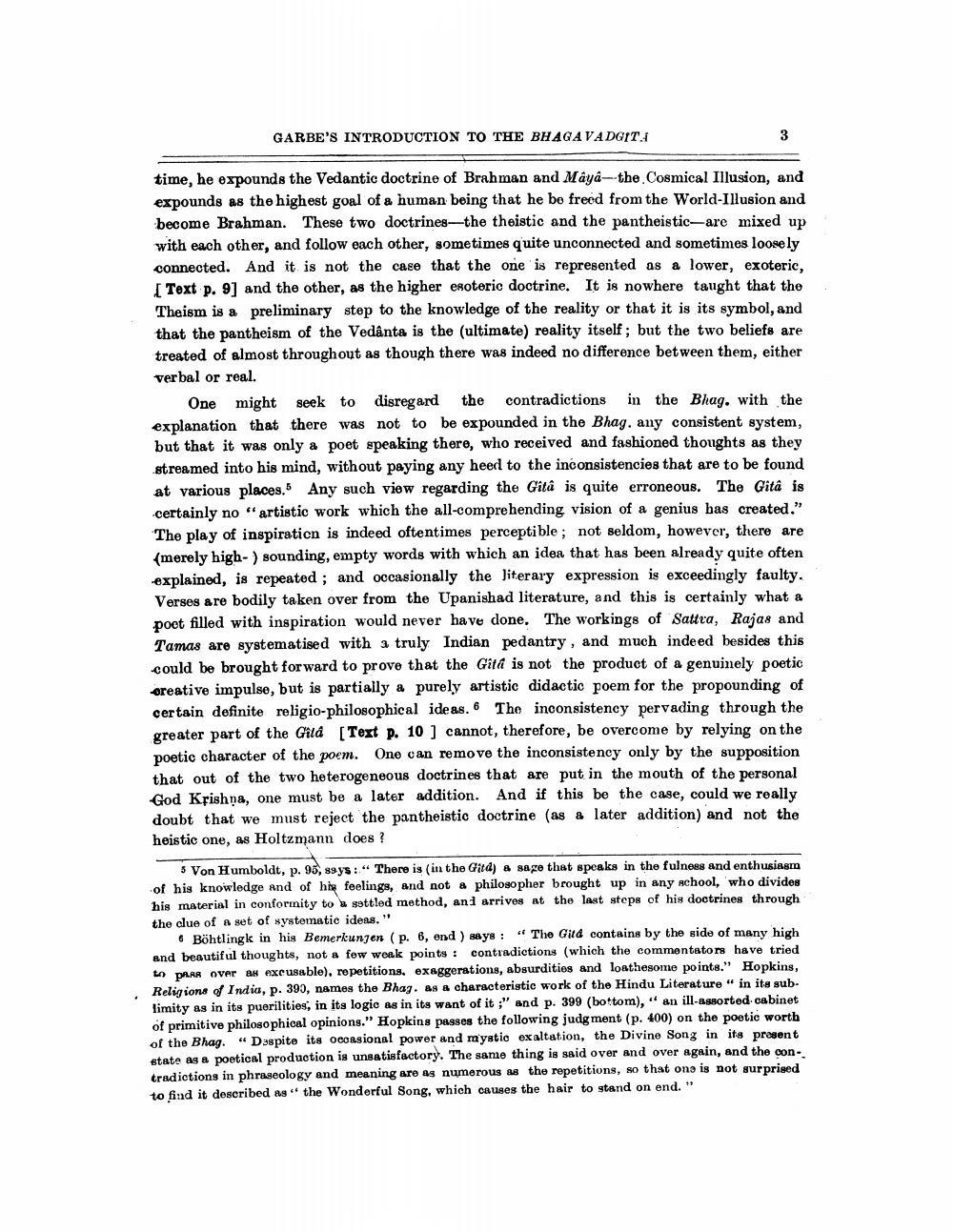________________
GARBE'S INTRODUCTION TO THE BHAGAVADGIT.
time, he expounds the Vedantic doctrine of Brahman and Maya--the Cosmical Illusion, and expounds as the highest goal of a human being that he be freed from the World-Illusion and become Brahman. These two doctrines—the theistic and the pantheistic-are mixed up with each other, and follow each other, sometimes quite unconnected and sometimes loosely connected. And it is not the case that the one is represented as a lower, exoteric, [Text p. 9] and the other, as the higher esoteric doctrine. It is nowhere taught that the Theism is a preliminary step to the knowledge of the reality or that it is its symbol, and that the pantheism of the Vedanta is the (ultimate) reality itself; but the two beliefs are treated of almost throughout as though there was indeed no difference between them, either verbal or real.
One might seek to disregard the contradictions in the Bhag. with the explanation that there was not to be expounded in the Bhag, any consistent system, but that it was only a poet speaking there, who received and fashioned thoughts as they streamed into his mind, without paying any heed to the inconsistencies that are to be found at various places. Any such view regarding the Gità is quite erroneous. The Gita is certainly no " artistic work which the all-comprehending vision of a genius bas created." The play of inspiration is indeed oftentimes perceptible; not seldom, however, there are (merely high- ) sounding, empty words with which an idea that has been already quite often explained, is repeated ; and occasionally the literary expression is exceedingly faulty. Verses are bodily taken over from the Upanishad literature, and this is certainly what a poot filled with inspiration would never have done. The workings of Sattra, Rajas and Tamas are systematised with a truly Indian pedantry, and much indeed besides this could be brought forward to prove that the Gita is not the product of a genuinely poetic creative impulse, but is partially a purely artistic didactic poem for the propounding of certain definite religio-philosophical ideas. 6 The inconsistency pervading through the greater part of the Guld [Text p. 10 ] cannot, therefore, be overcome by relying on the poetic character of the poem. One can remove the inconsistency only by the supposition that out of the two heterogeneous doctrines that are put in the mouth of the personal God Kfishna, one must be a later addition. And if this be the case, could we really doubt that we must reject the pantheistic doctrine (as & later addition) and not the heistic one, as Holtzmann does ?
5 Von Humboldt, p. 98, 99ys: There is in the Gitd) & sage that speaks in the fulness and enthusiasm of his knowledge and of hiu feelings, and not a philosopher brought up in any school, who divides his material in conformity to a settled method, and arrives at the last steps of his doctrines through the clue of a set of systematic ideas."
Böhtlingk in his Bemerkungen (p. 6, end) says: "The Guld contains by the side of many high and beautiful thoughts, not a few weak points : contradictions which the commentators have tried to PAAR over an excusable), repetitions, exaggerations, absurditios and loathesome points." Hopkins, Religions of India, p. 390, names the Bhay. as a characteristio work of the Hindu Literature" in its sublimity as in its puerilities, in its logic as in its want of it ;" and p. 399 (bottom)," an ill-assorted cabinet of primitive philosophical opinions." Hopkins passes the following judgment (p. 400) on the poetie worth of the Bhag. “Daspite its occasional power and mystic exaltation, the Divine Song in its present state as a poetical production is unsatisfactory. The same thing is said over and over again, and the con. tradictions in phraseology and meaning are as numerous as the repetitions, so that one is not surprised to find it described as the Wonderful Song, which causes the hair to stand on end."




